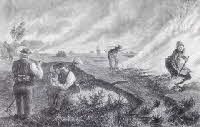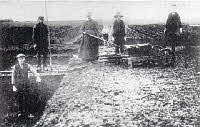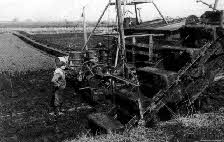|
Moor Burning Culture
From 1717 on attempts were made to cultivate the high moorlands without the use of a fen canal. Most commonly it was the impoverished sons of the farmers of the neighboring geest village who took the initiative to carve out their own property from the moor with the purpose of homesteading there (See Vossbarg.) Later, these moor settlements were expanded systematically, i.e. fully planned and laid out.To the left and right of a straight, accessible pathway, small land holdings were parcelled out and given (with rights of inheritance) to willing settlers. For the first six years the settlement was exempt from taxes or levies. Later, payment of an inheritance tax would be required. The settlers (called Kolonisten) lived in wretched huts made of wood and peat sod, mostly in one room in which the small animals were also housed. In order to drain the upper levels of the high moor, a row of spade-depth trenches was dug in the land during the summer months. In the fall, after the soil had dried somewhat and was a bit solid, the soil was loosened with a hoe. Then it was left to lie over during the winter. Freezing facilitated further drying. In the spring, the soil was again loosened up by hoeing.
 Beginning in May, after the upper layer was thoroughly dried out, the settlers, using shovels and iron pans, spread the glowing earth about the acreage. The dry peat began to burn and within about two or three days the moor was burned down to the lower damp soil layer. It's said that the smoke from this burning was noticeable all the way to southern Germany. Buckwheat, a fast growing, protein rich, coarse grass, (not a grain, as the name implies) was sown in the still warm ashes. Then the acreage was harrowed or disked and covered with heavy planks. Usually, the fastgrowing buckwheat was ready to harvest in three months. One could raise buckwheat on these acreages for about 4 to 6 years, until which time the soil was no longer suitable for this crop due to the depletion of the potassium which it required. Then it was possible to grow oats or rye for one or two years before the soil was depleted, so that it needed to lie fallow for the next 30 years. At first the buckwheat was extremely sensitive to frost. If a ground frost (which could happen as late as mid-June) occurred during the time of blooming , most of the seedlings would be damaged and would have to be reseeded. Of course, that was costly and a bitter fate for the settlers. Occasionally the entire crop was lost; a catastrophe for the impoverished settlers. Beginning in May, after the upper layer was thoroughly dried out, the settlers, using shovels and iron pans, spread the glowing earth about the acreage. The dry peat began to burn and within about two or three days the moor was burned down to the lower damp soil layer. It's said that the smoke from this burning was noticeable all the way to southern Germany. Buckwheat, a fast growing, protein rich, coarse grass, (not a grain, as the name implies) was sown in the still warm ashes. Then the acreage was harrowed or disked and covered with heavy planks. Usually, the fastgrowing buckwheat was ready to harvest in three months. One could raise buckwheat on these acreages for about 4 to 6 years, until which time the soil was no longer suitable for this crop due to the depletion of the potassium which it required. Then it was possible to grow oats or rye for one or two years before the soil was depleted, so that it needed to lie fallow for the next 30 years. At first the buckwheat was extremely sensitive to frost. If a ground frost (which could happen as late as mid-June) occurred during the time of blooming , most of the seedlings would be damaged and would have to be reseeded. Of course, that was costly and a bitter fate for the settlers. Occasionally the entire crop was lost; a catastrophe for the impoverished settlers.
Pancakes were baked out of the buckwheat flour, Boekweiten Schubbers, or Buchweizenbrei (buckwheat porridge) was cooked. Sometimes the buckwheat was used as feed for the livestock. Since there was no fen canal at hand, the peat could not be sold as a commodity.
 Peat was simply stored for personal use. Peat was simply stored for personal use.
A team (ploog) of 4 or 5 peat diggers was needed for this work. After the looser, top layer of peat, the embankment, was removed, the man standing ont he edge of the moor layer, stuck the ‘Sticker’ (special spade) into the peat at a right angle in even measurements, about the size of a brick. With a special spade called the Tweekrieger (two pronged spade), the one standing in the trench horizontally separated two of these "bricks" from the earth and laid it on the topsoil. The third person, often the owner's wife, piled the peat clods onto a peat cart, using a special fork called the Setfork. When the cart was fully loaded, the ‘Kröder’ wheeled the cart to a specified place on the dry land and laid the peat out in long rows for drying. When the peat was dried out on the surface, the pieces were piled in loosely arranged layers with the help of many hands. The next layer was crisscrossed over the first, and then the next layer, keeping everything straight at a 90 degree angle. Thus, small "towers" of 50 to 60 centimeters were constructed, through whose open passages the wind could blow and thoroughly dry out the peat. When fully dried, the peat brickettes were stored in stacks on the moor.
High Moor Culture
Finally, neither the fen culture or the moor burning culture could quench the desires or needs of the Ostfriesian people. Extreme privation and need were rampant between 1850 and 1900. Ostfriesland was oppressed by the shortage of affordable land, money and living staples. Increasing numbers of children burdened the family. The young land of America offered the depressed a tempting solution. Thus, it came about, that in the last half of the 19th century, hundreds of thousands of Ostfriesians emigrated to America. This emigration wave lessened only when the old homeland began to find new solutions. During the Hannoverian rule between 1815 and 1866, very little was done by the ruling classes to build up a stable lifestyle in Ostfriesland. Only after 1866, when the Prussian rule returned to Ostfriesland, did the situation change. A "Commission for the Enhancement of the Circumstances in the Moor Colonies of Ostfriesland as well as the Improvement of the Fiscal Usefulness of the Moors" was established. After a survey of the status and an analysis of earlier errors, a central moor commission was founded in 1876. This commission later took charge of a "German High Moor Culture" as developed in a research department of Bremen. This system abandoned the practice of burning the moors and the growing of buckwheat as well as the usual harvesting of peat as done in the fen areas. However, the high moor, as well as that of the fens, was basically drained of water. After the construction of the Ems-Jade Canal (1880-1888), this system was experimented with in the moor colony of Marcardsmoor. The moor soil was plowed, harrowed or hoed. In order to retain the moor nutrients, the soil was dressed with lime. Fertilizers used were the recently discovered chemical fertilizers: potassium chloride, nitrate and iron phosphate. Later animal dung was also used. The land remained the property of the state and was leased for 10 years.The moor officials created a cultivation plan, i.e. the rotation cycle and the fertilization. After ten years the land could be purchased. Thereafter, the homesteader was free to make his own decisions about the use and the disposal of the property. Originally, according to a mistaken assessment of the general commission, 90% of the area was to be used as agricultural land. In order to make this land productive, many sources of labor were necessary, more than a homesteading family could muster. Therefore, during the world wars, prisoners of war were used in the labor force. Between the wars the laborers were imported from Poland. All of these forces produced a minimum return - the homesteaders themselves had not been able to pay the regular rental costs. In addition, the land was not particularly suited for agricultural purposes, although it was suited for pastureland. So, today it is used as pastureland and for the production of feed.
The Peat Industry
 The conventional harvesting of peat could not satisfy the needs of the power-station for fuel. After the moors were drained, large excavation machines passed over the area and the peat was harvested in an open-pit method, similar to the method of mining soft coal. It was then compacted and laid on a platform in long strands to dry. At that point it was cut into uniform pieces of about 30 cm by mechanical knives and allowed to be dried by the wind and the sun. The rotation or turning of the pieces to accomplish a thorough drying-out process was later done by hand. Later machines did this task. Employment by the power-station was a boon for the residents of Vossbarg, the Auricher Wiesmoor II and further surrounding villages. The people found good paying jobs there. Along with the neighboring agricultural businesses the purchasing power of the area soon propelled Wiesmoor into a thriving, central community for the surrounding area. In the 1960s when the power-station gave way to a gas turbine power-station due to decreased profitability, the peat industry remained active. Various private, small business came to the moors with excavation machines and harvested the peat for the necessary household uses. This is also processed in the traditional manner as described above. Another important aspect of the harvesting of peat is the use of it as analternative fertilizer for nurseries and gardens. Environmetalists, however, reject the use of peat fertilizer and bedding material, suggesting that bark mulch should be used and the remaining moorlands set aside as nature preserves. The conventional harvesting of peat could not satisfy the needs of the power-station for fuel. After the moors were drained, large excavation machines passed over the area and the peat was harvested in an open-pit method, similar to the method of mining soft coal. It was then compacted and laid on a platform in long strands to dry. At that point it was cut into uniform pieces of about 30 cm by mechanical knives and allowed to be dried by the wind and the sun. The rotation or turning of the pieces to accomplish a thorough drying-out process was later done by hand. Later machines did this task. Employment by the power-station was a boon for the residents of Vossbarg, the Auricher Wiesmoor II and further surrounding villages. The people found good paying jobs there. Along with the neighboring agricultural businesses the purchasing power of the area soon propelled Wiesmoor into a thriving, central community for the surrounding area. In the 1960s when the power-station gave way to a gas turbine power-station due to decreased profitability, the peat industry remained active. Various private, small business came to the moors with excavation machines and harvested the peat for the necessary household uses. This is also processed in the traditional manner as described above. Another important aspect of the harvesting of peat is the use of it as analternative fertilizer for nurseries and gardens. Environmetalists, however, reject the use of peat fertilizer and bedding material, suggesting that bark mulch should be used and the remaining moorlands set aside as nature preserves.
|